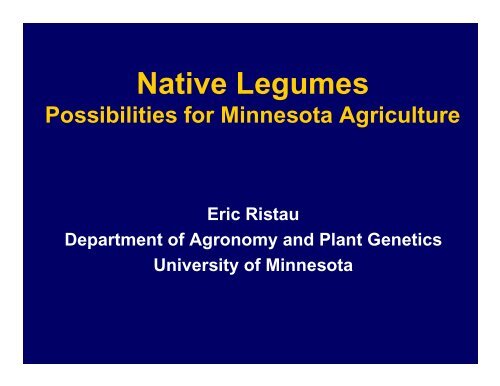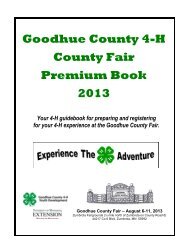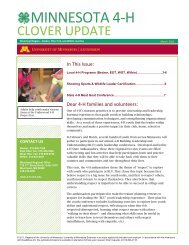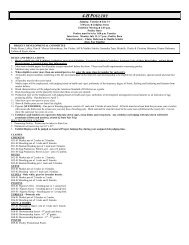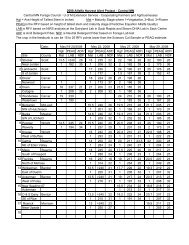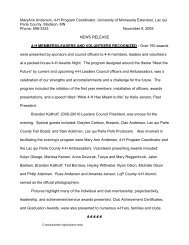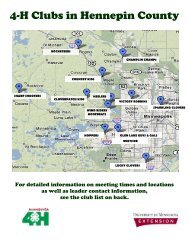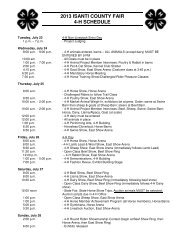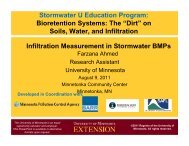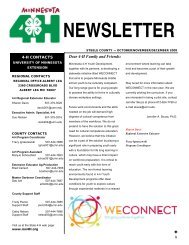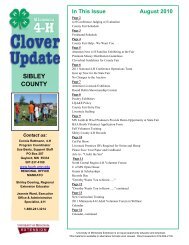Native Legumes - University of Minnesota Extension Service
Native Legumes - University of Minnesota Extension Service
Native Legumes - University of Minnesota Extension Service
You also want an ePaper? Increase the reach of your titles
YUMPU automatically turns print PDFs into web optimized ePapers that Google loves.
<strong>Native</strong> <strong>Legumes</strong><br />
Possibilities for <strong>Minnesota</strong> Agriculture<br />
Eric Ristau<br />
Department <strong>of</strong> Agronomy and Plant Genetics<br />
<strong>University</strong> <strong>of</strong> <strong>Minnesota</strong>
Research with Indigenous <strong>Legumes</strong><br />
- Evaluation <strong>of</strong> Agronomic Potential<br />
Species evaluated to date:<br />
Blue wild indigo (Baptisia australis)<br />
Wild senna (Senna hebecarpa)<br />
Illinois bundleflower (Desmanthus illinoensis)<br />
Hog peanut (Amphicarpaea bracteata)<br />
Round headed bush clover (Lespedeza capitata)<br />
Pale pea (Lathyrus ochroleucus)<br />
Veiny pea / Wild pea (Lathyrus venosus)<br />
Beach pea (Lathyrus maritimus)<br />
False indigo (Amorpha fruticosa )<br />
Leadplant (Amorpha canescens)<br />
Purple prairie clover (Dalea purpureum)<br />
White prairie clover (Dalea candidum)
Species evaluated to date (cont’d):<br />
Silky prairie clover (Dalea villosum )<br />
Wild licorice (Glycyrrhiza lepidota)<br />
Canada milkvetch (Astralagus canadensis)<br />
Ground plum (Astralagus crassicarpus)<br />
Small wild bean (Strophostyles leiosperma)<br />
Showy tick trefoil (Desmodium canadense)<br />
Wild lupine (Lupinus perennis)<br />
Scurfy pea (Psoralea tenuiflora)<br />
Breadroot (Psoralea esculenta)<br />
Prairie indigo (Baptisia bracteata)<br />
Dwarf false indigo (Amorpha nana)<br />
Partridge pea (Chamaecrista fasciculata)<br />
Maryland senna (Senna marylandica)<br />
American vetch (Vicia americana)<br />
Ascending purple milkvetch (Astralagus striatus)
<strong>Native</strong> Legume Garden, St. Paul (K-9)<br />
<strong>Native</strong> Legume Large Plots, St. Paul (Keller Block)
Blue wild indigo (Baptisia australis)<br />
Plant type: perennial, herbaceous, erect,<br />
non-spreading<br />
Potential use: grain, forage, biomass, horticulture
Blue wild indigo in large plot – full bloom
Wild senna (Senna hebecarpa)<br />
Plant type: perennial, herbaceous, erect,<br />
non-spreading<br />
Potential use: grain, biomass, fiber, wildlife
Illinois bundleflower (Desmanthus illinoensis)<br />
Plant type: perennial, herbaceous, erect or prostrate,<br />
non-spreading (but readily volunteers)<br />
Potential use: forage, grain, fiber, wildlife, cover,<br />
horticulture
5/22/98 6/10/98<br />
7/9/98 9/14/98
Hog peanut (Amphicarpaea bracteata)<br />
Plant type: annual, herbaceous vine, spreading,<br />
functions as perennial through nutlet<br />
Potential use: cover, natural food
Soybean with Hog peanut cover crop
Round headed bush clover (Lespedeza capitata)<br />
Plant type: perennial, herbaceous, erect,<br />
non-spreading<br />
Potential use: horticulture, fiber, wildlife
Pale pea (Lathyrus ochroleucus)<br />
Plant type: perennial, herbaceous vine,<br />
rhizomateous, spreading<br />
Potential use: forage, grain, biomass, cover
Veiny pea (Lathyrus venosus)<br />
Plant type: perennial, herbaceous vine,<br />
rhizomateous, spreading<br />
Potential use: forage, grain, horticulture, cover
Beach Pea (Lathyrus maritimus)<br />
Plant type: perennial, herbaceous vine,<br />
rhizomateous, spreading<br />
Potential use: forage, cover
False indigo (Amorpha fruticosa)<br />
Plant type: perennial, woody, non-spreading<br />
Potential use: silvopastoral, biomass, hort.,<br />
wildlife, agro-forestry, pharmaceutics
6/2/98<br />
7/9/98<br />
8/11/98 9/14/98
Leadplant (Amorpha canescens)<br />
Plant type: perennial shrub, erect, non-spreading<br />
Potential use: forage, horticulture, wildlife
Purple prairie clover (Dalea purpurea)<br />
Plant type: perennial, herbaceous,<br />
non-spreading, erect<br />
Potential use: forage, horticulture, wildlife
White prairie clover (Dalea candida)<br />
Plant type: perennial, herbaceous,<br />
non-spreading,erect<br />
Potential use: horticulture, forage, wildlife
Silky prairie clover (Dalea villosum)<br />
Plant type: perennial, herbaceous,<br />
non-spreading, semi-erect<br />
Potential use: horticulture, forage, wildlife
Wild licorice (Glycyrrhiza lepidota)<br />
Plant type: perennial, herbaceous, erect,<br />
aggressive spreading<br />
Potential use: biomass, fiber, ground cover
Canada milkvetch (Astralagus canadensis)<br />
Plant type: perennial, herbaceous, semi-erect,<br />
non-spreading<br />
Potential use: forage, wildlife
Ground plum (Astralagus crassicarpus)<br />
Plant type: perennial, herbaceous, prostrate,<br />
non-spreading<br />
Potential use: natural foods, wildlife, horticulture
Ascending Purple Milkvetch (Astralagus striatus)<br />
Plant type: perennial, herbaceous, prostrate,<br />
creeping-spreader<br />
Potential use: forage, wildlife
Small wild bean (Strophostyles leiosperma)<br />
Plant type: annual, herbaceous, creeping-prostrate<br />
Potential use: forage, cover, companion crop
Showy Tick Trefoil (Desmodium canadense)<br />
Plant type: perennial, herbaceous, upright,<br />
non-spreading (except through clinging seeds)<br />
Potential use: horticulture, fiber, wildlife
Wild Lupine (Lupinus perennis)<br />
Plant type: perennial, herbaceous, upright,<br />
non-spreading<br />
Potential use: forage, grain, horticulture, wildlife
Scurfy pea (Psoralea tenuiflora)<br />
Plant type: perennial, herbaceous, upright,<br />
non-spreading<br />
Potential use: forage, grain, horticulture, wildlife
Breadroot (Psoralea esculenta)<br />
Plant type: perennial, herbaceous, upright,<br />
non-spreading, large tuberous roots<br />
Potential use: natural food, wildlife
Prairie Indigo (Baptisia bracteata)<br />
Plant type: perennial, herbaceous, quite prostrate,<br />
non-spreading<br />
Potential use: horticulture, grain, hay
Dwarf/Fragrant False Indigo (amorpha nana)<br />
Plant type: perennial, woody, non-spreading<br />
Potential use: horticulture, wildlife, pharmaceutics
cm<br />
100<br />
80<br />
60<br />
40<br />
20<br />
0<br />
False<br />
indigo<br />
Perennial <strong>Native</strong> Legume<br />
Plant Heights at Harvest<br />
1st cut 2nd cut Average<br />
Blue wild<br />
indigo<br />
Goats<br />
rue<br />
Pale pea<br />
Flat pea<br />
Tuberous<br />
vetchling<br />
Wild<br />
senna
% Leaves<br />
Perennial <strong>Native</strong> Legume<br />
% Leaf Tissue<br />
90<br />
80<br />
70<br />
60<br />
50<br />
40<br />
30<br />
20<br />
10<br />
0<br />
1st cut 2nd cut Average<br />
False<br />
indigo<br />
Blue wild<br />
indigo<br />
Goats<br />
rue<br />
Pale pea<br />
Flat pea<br />
Tuberous<br />
vetchling<br />
Wild<br />
senna<br />
Alfalfa
kg/ha<br />
12000<br />
10000<br />
8000<br />
6000<br />
4000<br />
2000<br />
0<br />
False<br />
indigo<br />
Perennial <strong>Native</strong> Legume<br />
Dry Matter Production<br />
1st cut 2nd cut Total<br />
Blue wild<br />
indigo<br />
Goats<br />
rue<br />
Pale pea<br />
Flat pea<br />
Tuberous<br />
vetchling<br />
Wild<br />
senna<br />
Alfalfa
False indigo – cutting management
Relative consumption (visual 0-10)<br />
10.0<br />
9.0<br />
8.0<br />
7.0<br />
6.0<br />
5.0<br />
4.0<br />
3.0<br />
2.0<br />
1.0<br />
0.0<br />
Perennial <strong>Native</strong> Legume<br />
False<br />
indigo<br />
Relative Palatability<br />
1998(30hr) 1999(90hr) Ave<br />
Blue wild<br />
indigo<br />
Wild<br />
senna<br />
Illinois<br />
bundle<br />
flower<br />
Purple<br />
prairie<br />
clover<br />
Birdsfoot<br />
trefoil<br />
Alfalfa<br />
LSD.10
Prior to palatibility trial 24 hrs grazing by sheep<br />
90 hrs grazing by sheep<br />
Sheep with False indigo
% dry wt<br />
Perennial <strong>Native</strong> Legume Leaves<br />
90.0<br />
80.0<br />
70.0<br />
60.0<br />
50.0<br />
40.0<br />
30.0<br />
20.0<br />
10.0<br />
0.0<br />
False<br />
indigo<br />
Forage Quality<br />
ADF NDF Crude Protein IVDDM<br />
Blue wild<br />
indigo<br />
Wild<br />
senna<br />
Illinois<br />
bundle<br />
flower<br />
Purple<br />
prairie<br />
clover<br />
Birdsfoot<br />
trefoil<br />
Alfalfa<br />
LSD.10
k/ha DM<br />
3500<br />
3000<br />
2500<br />
2000<br />
1500<br />
1000<br />
500<br />
Amorpha fruticosa Establishment<br />
0<br />
- 2nd year Dry Matter Yields<br />
Clear<br />
seed,<br />
No herb.<br />
Clear<br />
seed,<br />
with<br />
herb.<br />
Oat<br />
companion,<br />
No herb.<br />
Becker Rosemount<br />
Oat<br />
companion,<br />
with herb.<br />
LSD.10
<strong>Native</strong> Legume Establishment (30 DAP)<br />
5 species seeded 6/16/99 @ 12.5 PLS/ft2<br />
7<br />
6<br />
5<br />
4<br />
3<br />
2<br />
1<br />
0<br />
Clipped PPI PRE<br />
Treflan Plateau<br />
plants/ft2 plant ht (cm)<br />
LSD.05
<strong>Native</strong> Legume Establishment (30 DAP)<br />
5 species seeded 6/16/99 @ 12.5 PLS/ft2<br />
9<br />
8<br />
7<br />
6<br />
5<br />
4<br />
3<br />
2<br />
1<br />
0<br />
False<br />
indigo<br />
Blue<br />
wild<br />
indigo<br />
Illinois<br />
bundle<br />
flower<br />
plants/ft2 plant ht (cm)<br />
Purple<br />
prairie<br />
clover<br />
Wild<br />
senna<br />
LSD.05
Management <strong>of</strong> <strong>Native</strong> <strong>Legumes</strong> in Establishment Year (30 DAP)
False indigo Blue wild indigo<br />
Illinois bundleflower Wild senna<br />
Management <strong>of</strong> <strong>Native</strong> <strong>Legumes</strong> in Establishment Year (1 year AP)
<strong>Native</strong> Legume Establishment (30 DAP)<br />
5 species seeded 6/16/99 @ 5 rates<br />
20<br />
18<br />
16<br />
14<br />
12<br />
10<br />
8<br />
6<br />
4<br />
2<br />
0<br />
False<br />
indigo<br />
Blue<br />
wild<br />
indigo<br />
Illinois<br />
bundle<br />
flower<br />
plants/ft2 plant ht (cm)<br />
Purple<br />
prairie<br />
clover<br />
Wild<br />
senna<br />
LSD.05
plant count/ft2<br />
<strong>Native</strong> Legume Establishment (30 DAP)<br />
5 species seeded 6/16/99 @ 5 rates<br />
25<br />
20<br />
15<br />
10<br />
5<br />
0<br />
1.25 6.25 12.5 25 50<br />
Seeding rate PLS/ft2<br />
LSD.05
False indigo Blue wild indigo<br />
Illinois bundleflower Wild senna<br />
<strong>Native</strong> Legume Establishment (30 DAP) 5 species seeded 6/16/99 @ 5 rates
Ongoing Programs<br />
Ecological / Agronomic Effects:<br />
Adaptation to diverse environments<br />
(SE & W MN)<br />
Compatibility with other species (warm and<br />
cool season)<br />
Effective legume – rhizobium symbiosis<br />
(J. Byun)<br />
Establishment strategies
Evaluation <strong>of</strong> Diversity Among Ecotypes <strong>of</strong><br />
Amorpha fruticosa and Desmanthus illinoensis<br />
(Lee DeHaan)<br />
20 Ecotypes <strong>of</strong> each species<br />
Three locations<br />
Three years<br />
Measured traits: seed yield, biomass yield, height, width, maturity,<br />
winter survival, leaf width, leaf length, insect resistance number <strong>of</strong><br />
stems<br />
Most traits influenced heavily by location (environment) and ecotype
Indigenous plants, especially<br />
legumes, provide new possibilities<br />
for <strong>Minnesota</strong> agriculture, whether<br />
it be for fiber, fuel, forage, grain,<br />
natural foods, or pharmaceutics.


